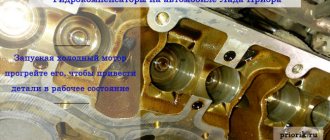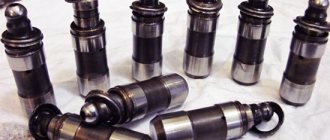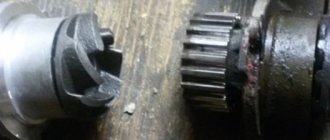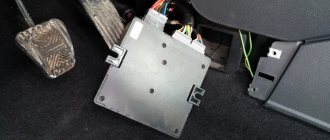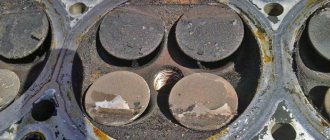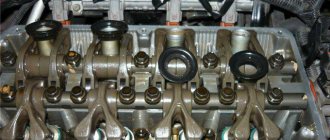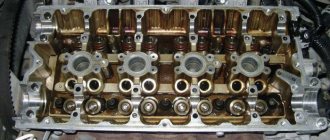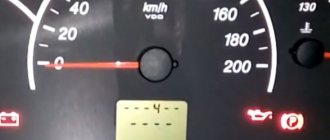Compensators are needed for automatic valve adjustment; if they were not there, it would be necessary to adjust the valves every 10 thousand, as on 2109. On the Prior, hydraulic compensators knock under different circumstances - and this is not always a malfunction.
They have a special knock, so experienced car enthusiasts will recognize it almost immediately. A knock that comes from the engine of a Priora car is not a very good sign that should alert you. Each car needs to be approached differently. Therefore, when hydraulic compensators on a Priora knock, make proper preparations for repairs - you need to find out what is the reason for what is happening and how you can eliminate it by correcting the situation. In this article, we have collected for you the main signs: why these parts make noise, whether the car is cold or hot.
Important: Even if the new hydraulic lifters are knocking, this is not a reason to prepare for the worst outcome - it sounds strange, but it is true. This is a VAZ, gentlemen, and everything can happen on it.
These parts have 16 valves on the Priora. (if taken as a complete set) they are not so little. The price starts from 4000 rubles and above. Replacing hydraulic compensators is labor-intensive and I don’t recommend getting into the engine yourself without experience. At a service station, such work for a Priora car will cost from 5,000 rubles and more.
The picture shows the valve seat - and in the middle there is a compensator
Why are hydraulic compensators needed on the VAZ 2170 Priora
A design element of a modern engine is designed to automatically adjust the valve position. The part allows you to eliminate the manual calibration procedure every 10,000 km, which makes car maintenance easier and helps increase the power of the power plant.
The design and principle of operation of hydraulic compensators on the Lada Priora
Structurally, the hydraulic compensator on Priora looks like a metal cylinder with a spring and a shut-off valve. Inside the part there are two smaller sleeves. The operating principle of the system is based on oil pressure in the plunger. When the pusher cam leaves, the cavity inside the hydraulic valve is filled with oil. At the end of the cycle, the container is completely filled and the cam begins to push the entire structure down (open the valve). In this case, the main valve pusher rests on the part and lowers it. The opening depth is adjusted by changing the pressure of the liquid entering under the plunger mechanism.
What's inside
The gap is adjusted automatically. The operating principle of hydraulic compensators is based on a negligible oil compression ratio. At the moment when the holes (made specifically for the passage of lubricant) in the cylinder head and the compensator body coincide, oil will flow into it. Next, it will enter the upper chamber of the plunger through the groove, and then, through the opened ball valve, it will fill the lower chamber.
Since the oil is supplied under pressure, the plunger is squeezed out, pushing the compensator body upward until it rests against the cam. The shaft cam, turning, presses on the hydraulic compensator, which goes down. The holes close, the oil flow stops and the ball valve closes.
The oil has the property of incompressibility, so the force of the timing shaft cam is transmitted through the hydraulic compensator to the automobile valve. It opens. Further movement of the cam causes the valve spring to push it up and it closes.
Some of the oil may leak through the plunger ball seat in the opposite direction, increasing the gap, but in the next cycle, when the oil pipe holes align again, the oil volume will be replenished and the gap will return to normal.
Why are hydraulic compensators knocking on a Priora with 16 valves?
A knocking sound during operation of parts appears when the supply of emulsion to the plunger is reduced and the pusher does not move evenly. The causes of the characteristic sound can be the following factors:
- Wear or low quality lubricant. The correct operation of the mechanism depends on engine oil. The technical clearances in the plunger are minimal, which requires the use of a high-quality consumable.
- Clogged fluid lines.
- Natural aging of parts. Main engines are designed for 100,000 km. Moreover, if the machine is operated in difficult conditions, the service life is reduced by 15-20%.
Constant knocking
It is observed only at increased engine speeds. Occurs as a result of an excess or lack of oil in the engine lubrication system. This may be due to damage to the oil receiver, which needs to be replaced with a working one. You may just need to bring the engine oil level up to normal.
Why do hydraulic compensators knock on a Priora when it’s cold?
The reasons for knocking parts on a cold engine can be several factors:
- The viscosity of the lubricant is incorrectly selected. Thick oil does not pass through small channels, which causes dry friction.
- Worn or contaminated lubricant. The presence of solid impurities, soot or soot makes it difficult for the mixture to flow freely.
- Low pressure inside the lines, pump malfunction.
- Jamming of the plunger mechanism due to sludge formation or misalignment of surfaces.
- Wear of the main body. Fatigue of the spring, shell on the check valve ball.
What's the result?
Taking into account the above information, we can conclude that there are many reasons for knocking hydraulic compensators. In some cases, it even happens that new hydraulic compensators are knocking. This happens when, in parallel, the engine oil was incorrectly selected, the oil filter is clogged, there are problems with the cleanliness of the lubrication system or the oil pump, or there are hidden or obvious engine problems that have not been eliminated.
Additionally, it is not recommended to immediately disassemble the internal combustion engine yourself for diagnostics, replacement or washing of hydraulic mounts without proper experience. The fact is that the cause of the knocking must be accurately established. There are quite common cases when, after washing and cleaning the hydraulic compensators, as well as the channels of the lubrication system, the knocking still remains. In such a situation, only professional engine diagnostics can help avoid possible consequences and unplanned financial costs.
Hydraulic compensators: what they are, what function they perform, hydraulic compensator malfunctions and symptoms. Do-it-yourself repair and washing of hydraulic compensators.
Valves knock on a cold engine or after warming up the engine: possible causes of valve mechanism knocking. Fault diagnosis, useful tips.
The most common causes of engine knocking are: piston knock, connecting rod knock, crankshaft knock. What to do if the engine suddenly starts knocking while driving.
Why a cold engine may knock: various malfunctions. Analysis of the nature of the knock in the power unit: ringing, metallic, muffled, etc.
What can knock, whistle, rustle and make other extraneous sounds under the hood after starting the engine. Diagnostics and determination of faults.
The appearance of knocking noises in different diesel operating modes. Fault diagnosis. The nature of the knocks of the crank mechanism, timing gear, and fuel equipment.
When do you need to change hydraulic compensators on a Priora?
Replacing hydraulic compensators on Priora is carried out in cases where other methods of repair or restoration are not relevant. Standard diagnostics will help identify such problems.
Diagnostics
It is first necessary to remove all hydraulic compensators from the engine, disassemble and clean them for detailed study. When troubleshooting, in 80% of cases motorists encounter the following problems:
- Worn or damaged integrity of the shut-off valve ball requires a complete replacement of the valve body.
- The presence of solid deposits on the surface of the part. To fix the problem, just wash all the components.
- Wear of the plunger pair is fraught with replacement of the block.
- The presence of scratches, chips, cracks on one or more surfaces of the mechanism also requires the installation of a new part.
How to identify a faulty hydraulic compensator on a Lada Priora
You can determine which hydraulics are faulty in a simple way. It is enough to press the covers with a screwdriver through a rag. If one element is pressed too easily or does not return to its original position, the unit must be repaired or replaced. This action can be repeated with 2 or more nodes. In this case, it is recommended to perform a comprehensive replacement.
We are taking action
So, the hydraulic compensators are knocking, what should you do? Do not panic. Such a phenomenon has not yet brought the car to exclusion from the transportation process.
The functioning of this important part is directly related to the lubrication system. If the hydraulic lifters are knocking, the likelihood that the oil has lost its original characteristics is quite high.
Don't immediately think about disassembling the engine. First of all, to eliminate knocking, change the oil and filter. After replacement, when starting, do not flinch from the knocking of the hydraulic compensators; during the process of draining the oil, it will leave them, and the plungers will fill when the oil pump starts.
If this does not help, then you need to find out which hydraulic compensator is knocking. The question arises, how to determine the one that needs to be changed? For example, the VAZ 2112 has 16 valves, how can you find out which one is not functioning?
To do this, you need to position the camshaft cam (rocker arm) so that it does not interfere and try to press the compensator with a drift. The serviceable one will press through if significant force is applied, the faulty one will go down easily. It needs to be removed.
How to replace hydraulic compensators on a Priora 16 valves with your own hands
Technically, replacing hydraulic compensators on the Lada Priora can be done independently. The VAZ engine does not have a complex design and the operation can be performed even by an amateur. However, this will require preparation. At the same time, for the Lada Priora hatchback and sedan the procedure is identical.
Necessary equipment
When performing work, the motorist will need the following set of tools:
- two screwdrivers (+;-);
- set of spanners;
- special sealant;
- magnet.
Sequence of actions when replacing hydraulic compensators VAZ 2170 Priora 16 valves
The procedure is as follows:
- Set the car to the parking brake.
- Turn off the power supply.
- Remove the power unit casing.
- Disconnect the ignition and injector power wires.
- Remove the crankcase ventilation pipes from the cylinder head.
- Remove the oil dipstick mount along with the element itself.
- Remove the exhaust manifold.
- Remove the casings and timing belt.
- Carefully remove the camshaft gears and the rear cover of the mechanism.
- Remove the cylinder head cover by first unscrewing 15 bolts.
- Unscrew the bearing housings.
- Having previously marked the position, remove the camshafts.
- Dismantle the hydraulic compensators and install new parts in their place, after lubricating them with oil. This can be done conveniently using a magnet.
Important! The manufacturer recommends replacing hydraulic compensators as a complete set. This is justified by the high probability of sequential failure of several components, which will provoke repeated repairs.
Moreover, after replacing parts, knocking can be observed during the first 2-3 starts of the power plant. If the noise does not stop, the problem is hidden in the lubricant supply. In this case, it is necessary to flush the crankcase compartment of the engine or decarbonize the pressure lines. You can see how the Lada Priora engine works after replacing the hydraulic compensators in the video:
Prevention
In order to protect the hydraulic lifters on the Priora 16 valve, you must follow the following recommendations:
- Use only high quality lubricants. Good oil can extend the life of the engine by 2-3 times.
- Perform vehicle maintenance in a timely manner, change fluids, and prevent worn-out lubricants. If the service interval for replacing lubricants is not observed, sediment may form and intensive sludge formation inside the internal combustion engine.
- Do not allow the motor to overheat. When the critical temperature is exceeded, the cylinder head may become deformed, which causes a displacement of the cylinder head axes and leads to their jamming.
- The service life of hydraulic valves on the VAZ 2170 in the sixteen-valve version is limited to 100,000 km.
It is recommended to carry out a preventive replacement already at 90,000 kilometers covered by the speedometer.
Consequences
Incorrect operation of hydraulic pushers can lead to the following problems:
- reduction in compression and engine power;
- deterioration of its launch;
- burnout of valve plates and seats;
- an increase in shock load on vehicle components and parts, which will lead to their rapid failure;
- increase in fuel consumption.
How much do hydraulic compensators cost on Priora?
Factory hydraulic compensators for Lada Priora are supplied under the article number - 21120-1007300-86 (As in the picture below). The same parts are suitable for the VAZ 2110. The cost of the kit is about 4,000 rubles. There is also an analogue on the market from. The replacement has catalog number No. 1-59718-219. The price for 8 pieces is 350 rubles.
The work of replacing the main valve costs about 4,000 rubles. At the same time, in Moscow and other cities, the amount of repairs may differ. Experienced motorists also recommend purchasing spare parts in advance from a trusted store and bringing them to a mechanic.
Basics of the design and operation of a hydraulic compensator
Configuration
The idea of automatic regulation of thermal clearances can be implemented in two versions: a conventional hydraulic pusher and a hydraulic support. The latter is used in gas distribution modules with rocker arms. On the Lada Priora in the sixteen-valve version, the intake and exhaust are equipped with individual camshafts. The optimal solution for this arrangement is the use of a hydraulic pusher.
The Priorov hydraulic compensator on the 126 engine consists of the following parts:
- A plunger pair, including a cylindrical cage and a piston with a ball valve.
- The outer housing is a pusher.
- System of grooves and holes for oil supply.
Principle of operation
The oil composition enters the internal cavity of the piston and, overcoming the resistance of the spring, pushes the ball away to fill the closed cylinder. When filling the liner, oil pushes the piston out and the hydraulic tappet rests against the cam. Next, the ball valve is locked and the assembly unit works like a regular pusher on motors with an adjustable valve mechanism.
